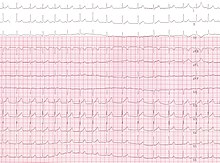
Back تسرع القلب الوصلي المنتبذ Arabic Junktionale ektope Tachykardie German Tachycardie jonctionnelle hisienne French Tachicardia ectopica giunzionale Italian
| Junctional ectopic tachycardia | |
|---|---|
| Other names | His bundle tachycardia |
 | |
| Specialty | Cardiology |
| Causes | Post-cardiac surgery |
| Differential diagnosis | AV nodal re-entrant tachycardia |
| Treatment | Correction of acidosis and electrolyte disturbances, antiarrhythmic medication, catheter ablation |
| Medication | Amiodarone, propranolol, verapamil, flecainide, propafenone |
Junctional ectopic tachycardia (JET) is a rare syndrome of the heart that manifests in patients recovering from heart surgery.[1] It is characterized by cardiac arrhythmia, or irregular beating of the heart, caused by abnormal conduction from or through the atrioventricular node (AV node).[2][3] In newborns and infants up to 6 weeks old, the disease may also be referred to as His bundle tachycardia or congenital JET.
- ^ Sarubbi B, Vergara P, D'Alto M, Calabro R (2003). "Congenital junctional ectopic tachycardia: presentation and outcome". Indian Pacing Electrophysiol J. 3 (3): 143–7. PMC 1502046. PMID 16943912. Archived from the original on 28 September 2021. Retrieved 21 December 2008.
- ^ "Supraventricular Tachycardia, Junctional Ectopic Tachycardia: Overview - eMedicine". Retrieved 21 December 2008.
- ^ Campbell, R. W. F.; Wren, C. (1987). "His bundle tachycardia- arrhythmogenic and antiarrhythmic effects of therapy". European Heart Journal. 8 (6): 647–650. doi:10.1093/oxfordjournals.eurheartj.a062336. PMID 3113958.